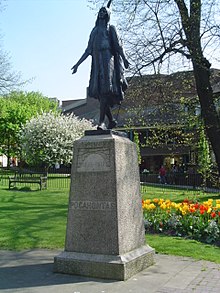St George's Church, Gravesend

| Church at Gravesend Act 1730 | |
|---|---|
| Act of Parliament | |
 | |
| Long title | An Act for rebuilding the parish church of Gravesend in the County of Kent, as one of the Fifty New Churches directed to be built by two Acts Of Parliament, one made in the Ninth, and the other in the Tenth year of the Reign of her late majesty Queen Anne. |
| Citation | 4 Geo. 2. c. 20 |

St George's Church, Gravesend, is a Grade II*-listed Anglican church dedicated to Saint George the patriarch of England,[1] which is situated near the foot of Gravesend High Street in the Borough of Gravesham. It serves as Gravesend's parish church and is located in the diocese of Rochester in Kent, England.
Burials
[edit]Pocahontas, Native American wife of English-born colonist John Rolfe, died in Gravesend on her way back to North America at age 20 or 21 and was buried under the chancel of this church on 21 March 1617. When the church was rebuilt in 1731, the exact spot was lost. William Ordway Partridge's bronze statue commemorates her.
After the Battle of Culloden in 1746, the many Jacobite Army POWs who died because of the inhumane conditions aboard the prison hulks anchored off Gravesend in the River Thames are believed to have been buried as "unknowns" in what was then the unconsecrated area of St. George's Cemetery. The most well known such burial is that of former non-combatant military chaplain and Roman Catholic Martyr Fr. Alexander Cameron, the younger brother of Donald Cameron of Lochiel.[2]
References
[edit]- ^ Historic England. "Details from listed building database (1089034)". National Heritage List for England. Retrieved 25 July 2013.
- ^ Thomas Wynne (2011), The Forgotten Cameron of the '45: The Life and Times of Alexander Cameron, S.J., Print Smith, Fort William, Scotland. Pages 89-91.
External links
[edit]![]() Media related to St George's Church, Gravesend at Wikimedia Commons
51°26′39″N 0°22′07″E / 51.44410°N 0.36850°E
Media related to St George's Church, Gravesend at Wikimedia Commons
51°26′39″N 0°22′07″E / 51.44410°N 0.36850°E
